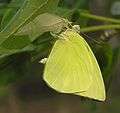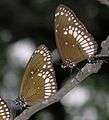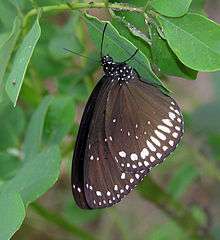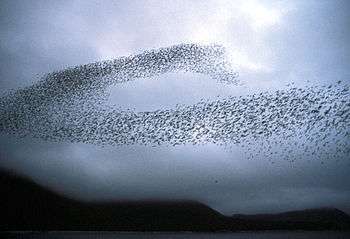Lepidoptera migration
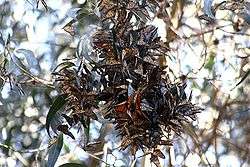
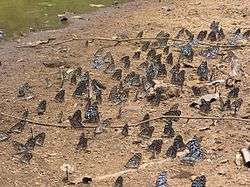
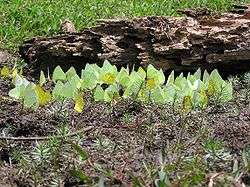
Many populations of Lepidoptera (butterflies or moths) migrate, sometimes long distances, to and from areas which are only suitable for part of the year. Lepidopterans migrate on all continents except Antarctica, including from or within subtropical and tropical areas. By migrating, these species can avoid unfavorable circumstances, including weather, food shortage, or over-population. In some lepidopteran species, all individuals migrate; in others, only some migrate.
The best-known Lepidopteran migration is that of the eastern population of the Monarch butterfly which migrates from southern Canada to wintering sites in central Mexico. In late winter/early spring, the adult monarchs leave the Transvolcanic mountain range in Mexico for a more northern climate. Mating occurs and the females begin seeking out milkweed to lay their eggs, usually first in northern Mexico and southern Texas. The caterpillars hatch and develop into adults that move north, where more offspring can go as far as Central Canada until next migratory cycle.
The Danaids in South India are prominent migrants, between Eastern Ghats and Western Ghats. Three species will be involved in this, namely Tirumala septentrionis, Euploea core, and Euploea sylvester. Sometimes they are joined by Lemon Pansy (Junonia lemonias), Common Emigrant (Catopsilia pomona), Tawny coster (Acraea terpsicore) and Blue Tiger (Tirumala limniace).
Definition
Migration in Lepidoptera means a regular, predictable movement of a population from one place to another, determined by the seasons.[1] There is no unambiguous definition of migratory butterfly or migratory moth, and this also applies to proposals to divide them into classes.[2] Migration means different things to behavioral scientists and ecologists. The former emphasize the act of moving whereas the latter discriminate between whether the movement has been ecologically significant or not. Migration may be viewed as "a behavioural process with ecological consequences".[1]
Migration in Lepidoptera takes place in two of the three modes of migration identified by Johnson (Johnson, 1969). In the first mode (also Johnson's first), the Lepidoptera move in one direction in their short life-span and do not return. An example is the pierid butterfly, Ascia monuste, which breeds in Florida but sometimes migrates along the coast up to 160 kilometers to breed in more suitable areas.[1]
In the second mode (Johnson's third), migration takes place to a place of hibernation or aestivation where they undergo diapause and the same generation survives to return. The classic example is that of the nymphalid Monarch butterfly (Danuas plexippus).[1]
Adventive
Species that are recorded in unexpected areas (adventive species) are not considered to be migratory species, because these did not leave their habitat on their own strength. Examples are species that are imported as egg or caterpillar alongside of their host plants or individuals that were reared by a collector but have escaped. An example of an introduced species is Galleria mellonella, which is found all over the world, because it is reared as food for captive birds and reptiles. At times it is difficult to decide if a species is adventive or migratory. Migratory species like Chrysodeixis chalcites and Helicoverpa armigera would be able to reach Western Europe on their own, but are also common in greenhouses.
Seasonal migration
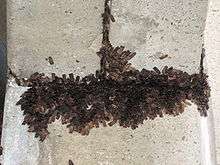
Lepidoptera migration is often seasonal. With species of which all individuals migrate, the population moves between areas in the summer and winter season or the dry and wet season.
For species of which only part of the population migrates, seasonal migration is hard to determine. They can maintain themselves in part of their habitat but also reach areas where they cannot establish a permanent population. They only live there in the season that is most favorable for the species. Some of the species have the habit of returning to their permanent residence at the end of the season.
Difference with bird migration
An important difference with bird migration is that an individual butterfly or moth usually migrates in one direction, while birds migrate back and forth multiple times within their lifespan. This is due to the short lifespan as an imago. Amazingly the Monarch receives no navigation instruction for the migration from their parents, unlike birds.[3][4] Species that migrate back and forth, usually do so in different generations. There are however, some exceptions:
- The famous migration of the Monarch butterfly in North America. This species migrates back and forth in one generation, though it completes only part of the journey in both directions in that generation. No individual completes the entire journey which is spread over a number of generations. The imago of the last summer generation is born in North America, migrates to Mexico, Florida, or California and stays there for the winter. After the winter it migrates back to the north to reproduce. In a couple of generations, the monarch migrates north to Canada.
- The migration of Agrotis infusa in Australia. This species migrates from south-eastern Australia to the Australian Alps in the summer to avoid the heat. After the summer it returns to reproduce.
Flight behaviour

Migratory Lepidoptera are, in most cases, excellent flyers. Species like the Vanessa atalanta are capable of managing a fierce headwind. In case of headwind, they usually fly low and are more goal-oriented.[5] During migration, some species can be found on high altitudes, ranging to up to two kilometers [6][7] This is especially noteworthy for day-flying species like Vanessa atalanta, since the temperatures on these altitudes are low and day-flying species depend on the outside temperature to stay warm. It is thought that Vanessa atalanta produces enough body warmth during flight since it has also been recorded migrating at night.
In the case of transcontinental migration where distances are large, the flying speed of the butterfly ( of the order of 3 metres per second or less) is inadequate for timely completion of journey. The migration is carried out by relying on heavy winds; a persistent wind speed of 10 metres per second being able to provide a displacement of 300 to 400 kilometers in a single day.[8] For example, the Painted Lady (Vanessa cardui) migrates from Africa to Spain aided by tail winds.[9]
That the migratory species are good flyers, is not the same as saying they are robust flyers. The small Diamondback moth is also a migratory species that migrates 3,000 kilometers and can be found up to altitudes of 100 meters or more.[10][11]
Navigation
To be able to migrate over long distances, species must be able to navigate. There are several ways they do this.
Landscape: Lepidoptera use coastal lines, mountains, but also man-made roads to orient themselves. Above sea it has been observed that the flight direction is much more accurate if the landscape on the coast is still visible.[5]
Celestial navigation: Butterflies are known to be capable of navigation with the help of the sun. They can also navigate by using polarized light. The polarization of the sun's light changes with the angle of the rays, hence they can also navigate with cloudy weather. There are indications that they can even make corrections depending on the time on a day. Diamondback moths are known to fly in a straight trajectory which is not dependent on the angle of the sun's rays.[12] Tests have been performed to interfere with the biological clock of certain species by keeping them in the dark and then observing if they would choose for other flight paths. The conclusion was that some species did, and others did not.[13] Research on monarchs demonstrates that with removal of antennae, the location of the circadian clock, individuals do not localize in any one direction during flight as they do with antennae intact.[14] Night flyers cannot use sun light for navigation. Most of these species rely on the moon and stars instead.
Earth’s magnetic field: A number of moths use the Earth's magnetic field to navigate, as a study of the stray Heart and Dart[15] suggests. Another study, this time of the migratory behaviour of the Silver Y, showed that this species, even at high altitudes, can correct its course with changing winds, and prefers flying with favourable winds, which suggests a great sense of direction.[16] Aphrissa statira in Panama loses its navigational capacity when exposed to a magnetic field, suggesting it uses the Earth’s magnetic field.[17]
Areas where migratory butterflies and moths can be found
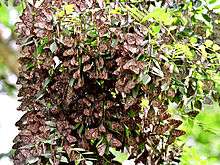
Migratory Lepidoptera can be found on all continents, migrating within or from the Tropics and Subtropics. North, they can be found up to Spitsbergen, above the Arctic Circle.[11] Some migratory Lepidoptera have spread over most of the world. Some of these are pest insects, such as the diamondback moth, Helicoverpa armigera, and Trichoplusia ni.
Examples of migratory Lepidoptera
Some examples of Migratory Lepidoptera are:
- In the Indian subcontinent, migrating Lepidoptera are common just before the monsoon season. Over 250 species are known to migrate during this period.[18][19]
- On Madagascar, Chrysiridia rhipheus migrates between populations of four plant species from the Omphalea genus, the host plant of this species. The three western Omphalea species live in dry coniferous forests, the eastern species is found in the rainforest and is the only species that is green year round.[20]
- Rhodometra sacraria is normally found in Africa, large parts of Asia and Southern Europe. At times, it migrates north and can reach central and northern Europe.
- Vanessa cardui is found all over the world, except South America, on altitudes of up to 3,000 meters above sea level. Its home, however, are subtropical steppe areas.
- Several South and Central American species of Uraniidae display a great peak in migratory behavior in certain years. In the years with a great number of migrating individuals, there are “population explosions”. Individuals migrate to the south and east. There is no real re-migration to speak off. These moths feed on Omphalea species. These can be found in scattered populations all across South and Central America, but only part of the areas where they are found are a permanent habitat for these moths. Research suggests that the cause of the migration peak is an increase in toxicity when much of a single plant is eaten and decreasing toxicity when only small amounts of a certain plant are eaten.[21]
- The migration of Euploea core, Euploea sylvester, Tirumala septentrionis, and Tirumala limniace between Western Ghats and Eastern Ghats in India covering up to 350 to 400 km. This migration happens twice a year. The most probable reasons seem to be the heavy monsoons, reproductive diapause, and a lack of host plants, nectar and alkaloidal resource availability.
- The Australian Painted Lady periodically migrates down the cost of Australia.[22] Occasionally, in periods of strong migration in Australia, these butterflies have been known to migrate to New Zealand.[22]
- The Gatekeeper butterfly (Pyronia tithonus) from Southern and Eastern Britain has been expanding to Northern Britain over the past three decades, despite their preference for warmer conditions.[23]
Example species: Macroglossum stellatarum
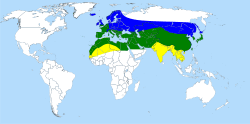
Macroglossum stellatarum is a moth that is recorded in the subtropical part of the Palearctic ecozone year round. In summer, the species disperses north up to Scandinavia and Iceland. In winter it migrates further south, deeper into Africa and to the Indian subcontinent.
In the Netherlands and Belgium, there are 100 to 200 records per year in an average year. In warm summers however, like the years 2005 and 2006, several thousand are recorded.[24] In mild winters, small numbers can survive this far north, but these numbers are insufficient to call it a real population.[2]
Causes
Usually, butterflies and moths migrate to escape from potentially harmful circumstances. Examples of this are a shortage of proper food plants, an unfavorable climate, like cold or extreme rain or overpopulation.
Migration and evolution
A phenomenon like migration is an evolutionary development. By migrating, the species has survived the process of natural selection. There are a number of advantages and disadvantages to migration. An example of this is the protozoan Ophryocystis elektroscirrha a parasite of the monarch. Severely infected individuals are weak, unable to expand their wings, or unable to eclose, and have shortened lifespans, but parasite levels vary in populations. This is not the case in laboratory or commercial rearing, where after a few generations, all individuals can be infected.[25] Infection with this parasite creates an effect known as culling whereby migrating monarchs that are infected are less likely to complete the migration. This results in overwintering populations with lower parasite loads.[26]
Recording

Butterflies (and to a lesser extent moths) migrating in large numbers are a noteworthy sight, which is easily to observe and track. There are several historic records about migrating butterflies. There are records dating back to 1100 about migrating butterflies (probably a Pieris species) from Bavaria to the Duchy of Saxony and from 1248 about the migration of yellow butterflies in Japan.
When flying at high altitudes, spotting migrating butterflies or moths can be hard. Low flying species are easily spotted or caught using a light trap. When individuals fly too high for these methods, air balloons equipped with nets are used at times. Alternatively, radar is used to monitor migration.[10]
Another registration technique, is marking the wings with tiny stickers, a technique comparable with Bird ringing. This technique has not proven to be very successful though.[5] Advances in technology might make it possible to equip individuals with micro transmitters in the future.
Migration and climate change
Global warming has caused an increase of migratory butterflies and moths that reach north-western European countries like the Netherlands, Belgium and the United Kingdom. Research in the United Kingdom confirms that an increasing number of migrants reach the country. Because one would expect that migratory species can adapt to new circumstances quite well, the researches warn for new species that can have a negative impact on native species and possible damage to both health (species like the Oak Processionary) and agriculture.[27]
See also
- Animal migration
- Butterflies
- Butterfly house (conservatory)
- Conservation biology
- Monarch butterfly conservation in California
- Monarch butterfly migration
Footnotes
- 1 2 3 4 Scoble, MJ. (1995) "Migration" in The Lepidoptera: form, function and diversity. 68-71. Previewed in Google Books on 09 Oct 2009.
- 1 2 Meerman, J.C. (1987) "Dutch Sphingidae" Wet. meded. KNNV 180.
- ↑ http://dsc.discovery.com/tv-shows/curiosity/topics/10-most-important-insects.htm
- ↑ Steven M. Reppert; Robert J. Gegear; Christine Merlin (September 2010). "Navigational Mechanisms of Migrating Monarch Butterflies". Trends in Neurosciences. 33 (9): 399–406. doi:10.1016/j.tins.2010.04.004. PMC 2929297
 . PMID 20627420.
. PMID 20627420. - 1 2 3 J. Blab, T. Ruckstuhl, T. Esche en R. Holzberger (1989) Actie voor Vlinders, zo kunnen we ze redden, Weert: M&P.
- ↑ Gibo, D.L. (1981). "Altitudes attained by migrating monarch butterflies, Danaus p. plexipus (Lepidoptera: Danaidae), as reported by glider pilots". Canadian Journal of Zoology. 59 (3): 571–572. doi:10.1139/z81-084.
- ↑ Mikkola, K. (2003). "The Red Admiral butterfly (Vanessa atalanta, Lepidoptera: Nymphalidae) is a true seasonal migrant: an evolutionary puzzle resolved?" (PDF). European Journal of Entomology. 100 (4): 625–626. doi:10.14411/eje.2003.091.
- ↑ Drake, V.A.; Gatehouse, A.G. (1995). Insect migration: tracking resources through space and time. Cambridge University Press. p. 3. ISBN 978-0-521-44000-4. Retrieved 6 May 2010.
- ↑ Stefanescu, C.; Alarcón, Marta; Àvila, A. (2007). "Migration of the painted lady butterfly, Vanessa cardui, to north-eastern Spain is aided by African wind currents". Journal of Animal Ecology. 67 (5): 888–898. doi:10.1111/j.1365-2656.2007.01262.x.
- 1 2 Chapman, J.W.; Reynolds, DON R.; Smith, A.D. (2003). "Vertical-Looking Radar, A New Tool for Monitoring High-Altitude Insect Migration" (PDF). BioScience. 53 (5): 503–511. doi:10.1641/0006-3568(2003)053[0503:VRANTF]2.0.CO;2.
- 1 2 Yau I-Chu (1986) "The Migration of Diamondback Moth" in: Diamondback Moth Management, Proceedings of the First International Workshop, Tainan, Taiwan, 11–14 March 1985. Shanhua: The Asian Vegetable Research and Development Center. Inhoud.
- ↑ Scott, J.A. (1992). "Direction Of Spring Migration Of Vanessa cardui (Nymphalidae) In Colorado" (PDF). Journal of Research on the Lepidoptera. 31 (1–2): 16–23. Archived from the original (PDF) on 2006-09-06.
- ↑ Oliveira, E.G.; Dudley; Srygley, R.B. (1996). "Evidence for the use of a solar compass by neotropical migratory butterflies". Bulletin of the Ecological Society of America. 775: 332.
- ↑ Merlin, C.; Gegear, R.J.; Reppert, S.M. (2009). "Antennal circadian clocks coordinate sun compass orientation in migratory monarch butterflies" (PDF). Science. 325 (5948): 1700–4. doi:10.1126/science.1176221. PMC 2754321
 . PMID 19779201.
. PMID 19779201. - ↑ Baker, R.R. (1987). "Integrated use of moon and magnetic compasses by the heart-and-dart moth, Agrotis exclamationis". Animal Behaviour. 35: 94–101. doi:10.1016/S0003-3472(87)80214-2.
- ↑ Scientists make compass discovery in migrating moths, University of Greenwich.
- ↑ Srygley, R; Dudley, R; Oliveira, E; Riveros, A (2006). "Experimental evidence for a magnetic sense in Neotropical migrating butterflies (Lepidoptera: Pieridae)" (PDF). Animal Behaviour. 71: 183–191. doi:10.1016/j.anbehav.2005.04.013.
- ↑ C.B. Williams (1930) The Migration of Butterflies Oliver & Boyd: Edinburgh.
- ↑ Senthilmurugan, B. (2005). "Mukurthi National Park: A migratory route for butterflies". J. Bombay. Nat. Hist. Soc. 102 (2): 241–242.
- ↑ Smith, N. (1991). "Foodplants of the Uraniinae (Uraniidae) and their Systematic, Evolutionary and Ecological Significance" (PDF). The Journal of the Lepidopterists' Society. 45 (4): 296–347.
- ↑ Smith, N.G. (1983). "Host Plant Toxicity and Migration in the Dayflying Moth Urania" (PDF). Florida Entomologist. 66 (1): 76–87. doi:10.2307/3494552. JSTOR 3494552.
- 1 2 Dingle, Hugh; Zalucki, Myron P.; Rochester, Wayne A. (1999). "Season-specific directional movement in migratory Australian Butterflies". Australian Journal of Entomology. 38: 323–329. doi:10.1046/j.1440-6055.1999.00117.x.
- ↑ Merckx, Thomas; Hans Van Dyck (July 2002). "Interrelations Among Habitat Use, Behavior, and Flight-Related Morphology in Two Cooccurring Satyrine Butterflies, Maniola jurtina and Pyronia tithonus". Journal of Insect Behavior. 4 15: 541–561.
- ↑ Vlindernet. Retrieved on 2008-08-26.
- ↑ Leong, K. L. H.; M. A. Yoshimura; H. K. Kaya; H. Williams (1997). "Instar Susceptibility of the Monarch Butterfly (Danaus plexippus) to the Neogregarine Parasite, Ophryocystis elektroscirrha". Journal of Invertebrate Pathology. 69 (1): 79–83. doi:10.1006/jipa.1996.4634. PMID 9028932. Lay summary.
- ↑ Bartel, Rebecca; Oberhauser, Karen; De Roode, Jacob; Atizer, Sonya (February 2011). "Monarch butterfly migration and parasite transmission in eastern North America". Ecology. 92 (2): 342–351. doi:10.1890/10-0489.1. PMID 21618914.
- ↑ Sparks, T.H.; Dennis, R.L.H.; Croxton, P.J.; Cade, M. (2007). "Increased migration of Lepidoptera linked to climate change" (PDF). European Journal of Entomology. 104 (1): 139–143. doi:10.14411/eje.2007.019.
References
- Bos, F. et al. (2006) De Dagvlinders van Nederland (Nederlandse Fauna, deel 7), Utrecht en Leiden, p. 13.
- Drake,V.A. and Gatehouse,A.G. (1995), Insect Migration: Tracking Resources Through Space and Time, Cambridge University Press. (ISBN 0521440009). Google Books
- Lempke,B.J. De Nederlandse Trekvlinders, Zutphen (KNNV-Thieme), 1956. Tweede druk in 1972.
- Kuchlein,J.H. and de Vos,R. (1999). Geannoteerde Naamlijst van de Nederlandse Vlinders, Leiden (Backhuys).



